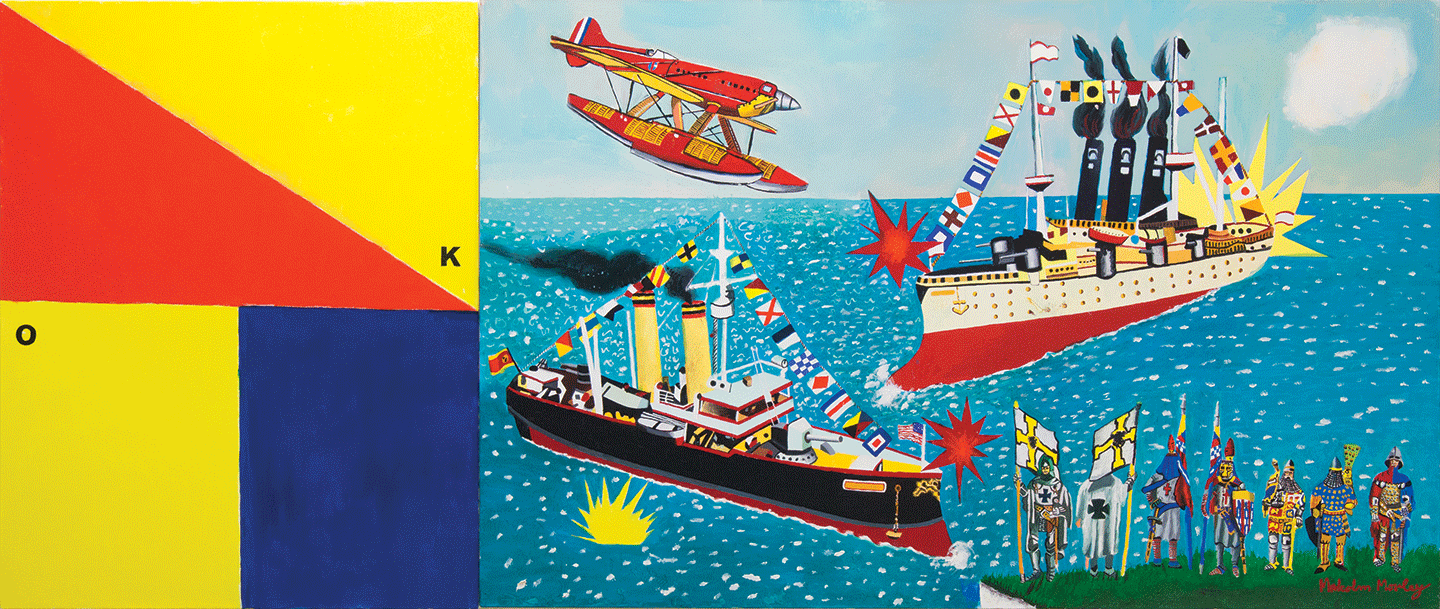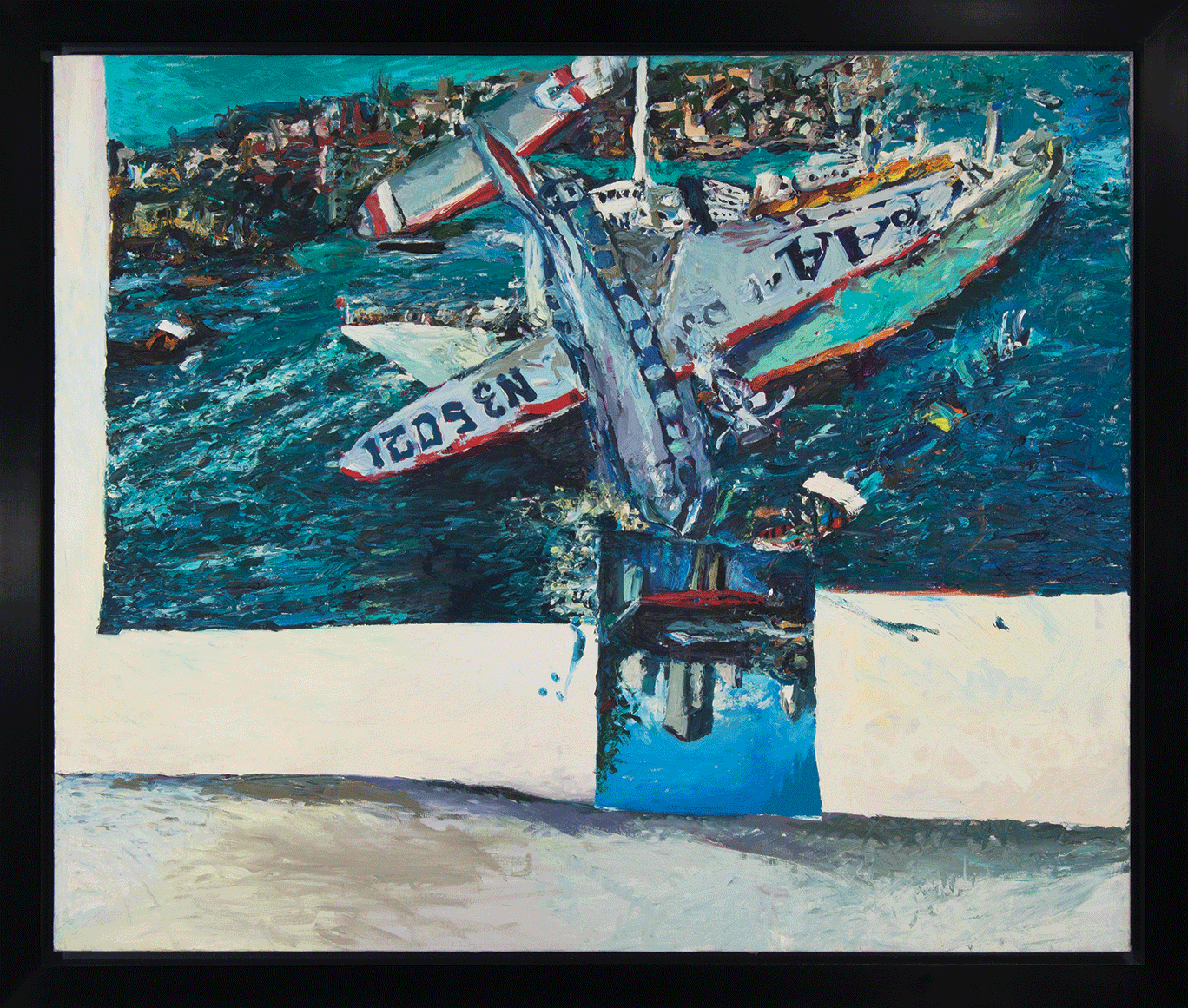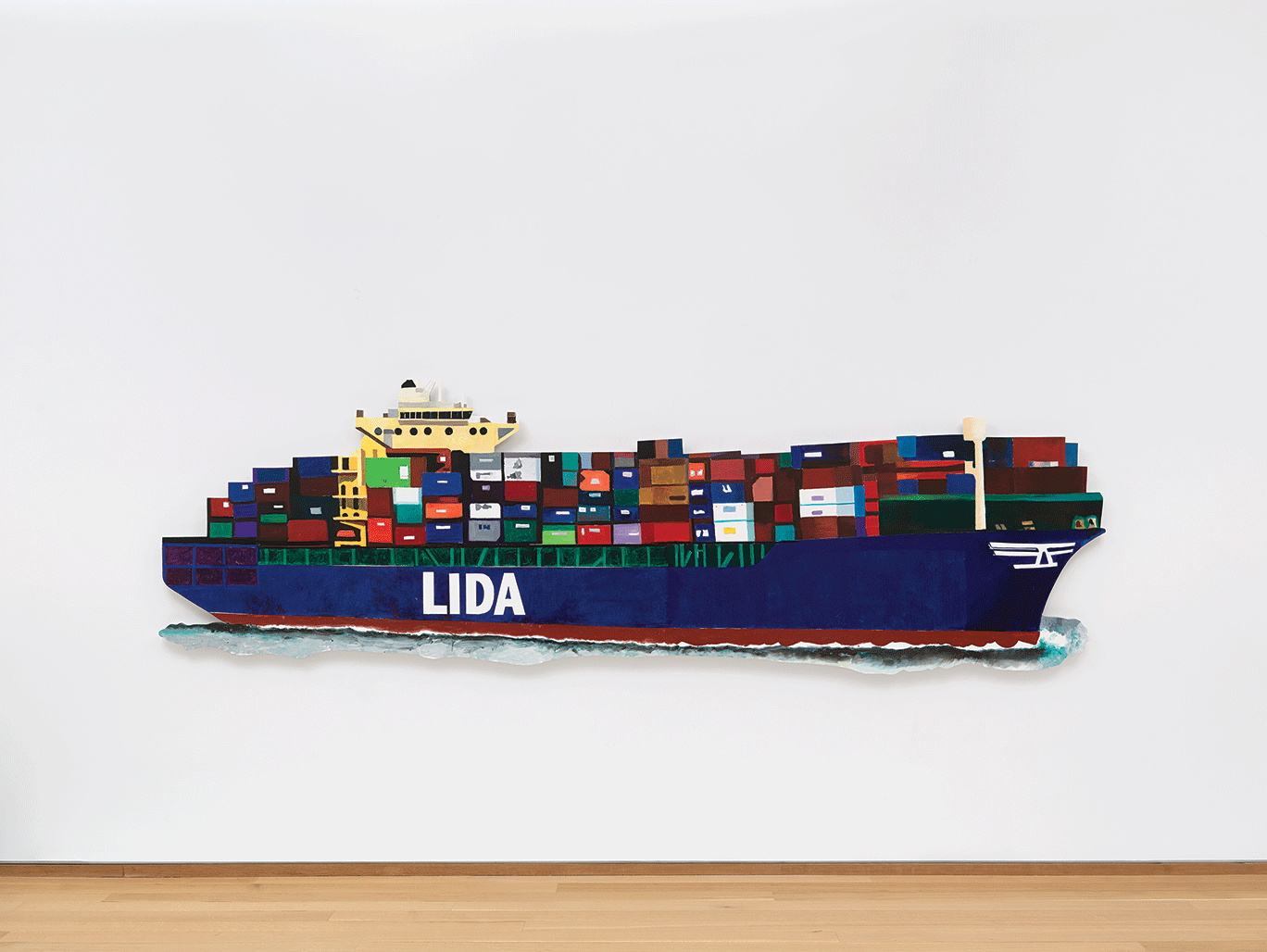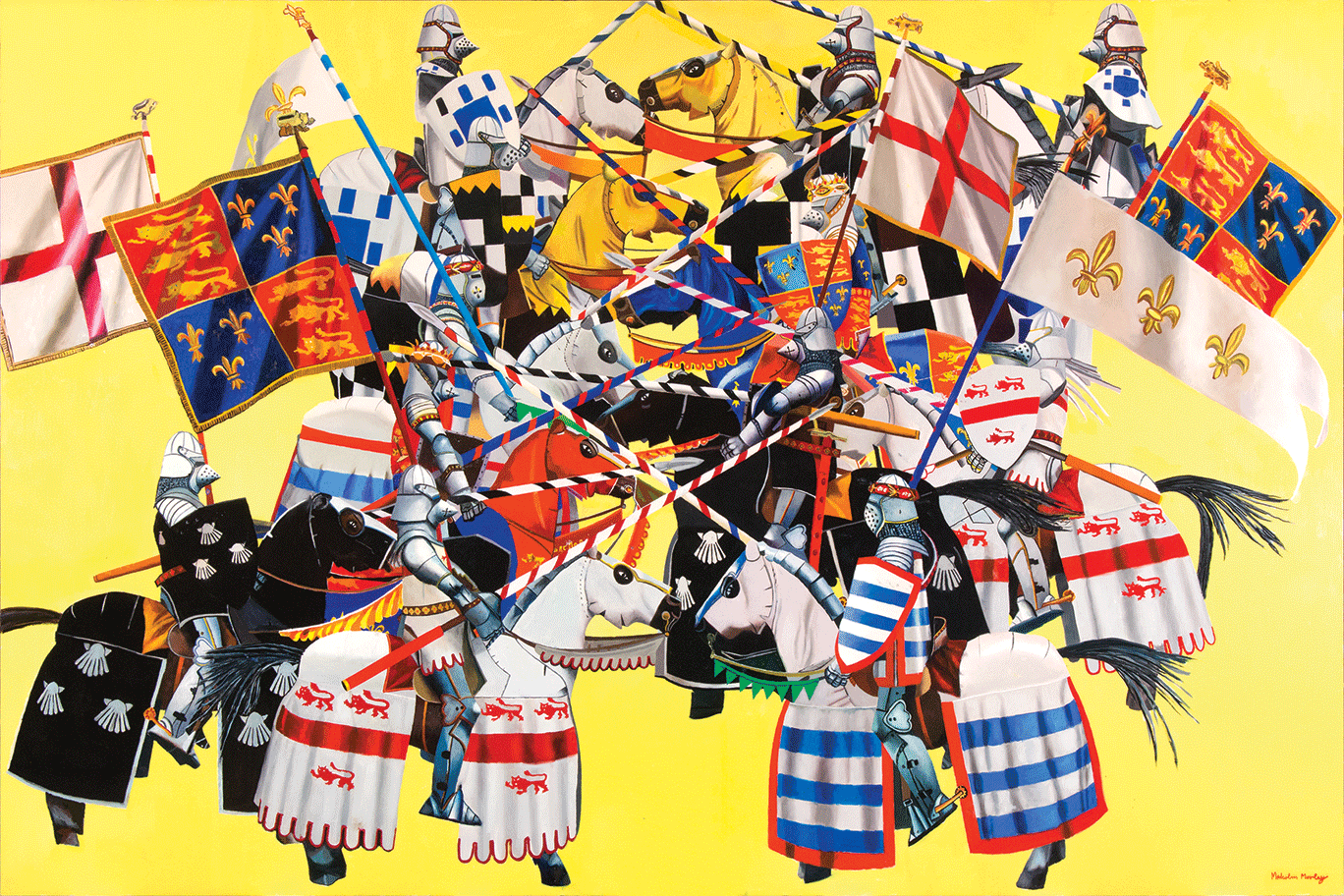« Feature
Malcolm Morley

Malcolm Morley, Starry Starry Knight, 2017, oil on linen, 50” x 50.” Copyright the Estate of Malcolm Morley. Courtesy Sperone Westwater, New York.
“Tally-ho,” Malcom Morley’s late, last work at Sperone Westwater in the Bowery of New York City, is a battle royal starring larger and brighter than life medieval knights, exquisitely painted sets of armors, shields, banners and castles in a world where, at any moment, mounted knights can fly, Trojan horses spar with an intergalactic spaceship-like creature, and men, ready for combat, are cross jousting lances without ever spilling a single drop of blood.
Morley, who died in June of last year, just three months before the opening of this show, was, in many ways, painting his postscript. Throughout the new works, completed just months before his own death, are warriors and leaders also struggling with death, some in their last gasp. And throughout his long career, painting was in fact a struggle against time, money, five marriages, bouts with suicidal depression and a near constant search for perfection, reinvention and originality.
The nearly 10-foot-wide Melee at Agincourt (2017) arrests the viewer upon entering the space. The massive work on linen features a dozen or more of his intricately painted knights in a head-on collision against an almost neon lemon, yellow backdrop-so yellow you want to smack your lips, and look again. Morley, who relentlessly searched for new ways to juxtapose ideas and capture conflict in his work, put the knights’ race toward death against a massive yellow backdrop for a reason. Did he just love the bright color or was it the intended irony of optimism and cowardice the color usually represents he sought to capture? I would argue the later and that his intention was for the painting, created on such a grand scale, to reverberate over and again throughout time, history and context. An endless collision of the senses.

Malcolm Morley, O.K., 2015, oil on linen, 26 ½” x 63.” Copyright the Estate of Malcolm Morley. Courtesy Sperone Westwater, New York.
In Starry Starry Knight, 2017, oil on linen, 50 x 50, Morley’s horseback knights face off with cannon and bow toting warriors in the foreground while others on flying horses dodge Van Gogh’s famous yellow stars appropriated from Starry Night Over the Rhone. The way Morley holds up Van Gogh’s stars in both tribute and satire reminds me of the title of the late David Foster Wallace’s book, Infinite Jest, a reference to the scene when Hamlet holds the skull of the court jester Yorick, and says, “Alas, poor Yorick! I knew him, a fellow of infinite jest… he hath borne me on his back a thousand times.”
Most of the show, brilliantly curated by Angela Westwater, Morley’s longtime gallerist and friend, represents new work, dating between 2015-2018. But included are works from the nearly seven decades and numerous styles in which the artist worked.
The beautifully illustrated, 68-page catalogue of the show includes an introduction by Sir Nicholas Serota, Chair of the Arts Council of England, and an essay by Tim Barringer, Mellon Professor of the History of Art, at Yale. In his essay, Barringer includes a still from the 1938 film, Alexander Nevsky, in which knights face off on a frozen lake. The black and white still is eerily similar to Morley’s movie screen-size painting. Barringer writes that a “pivotal moment” in Morley’s career came when he saw Sergei Eisenstein’s historical epic film, perhaps at MoMA’s screening in 1959. “The Russian director’s ability to create patterns of formal rigor and intensity within a realist idiom fascinated Morley. Battle scenes framed by geometric motifs of lances and pennants, with heraldic devices of crosses and chevrons emblazoned on shields, struck him forcefully.”
Morley (1931-2018) first started examining the relationship between photography and painting in the mid-sixties. Astonishingly, Morley initiated two major art movements in the 20th century, Photo Realism and Neo Expressionism, and he brought along generations of artists into the world of making art more real, or “Super Real” as he estimated, from original images, paintings, postcards or family photos.
I first met Morley and learned of his intricate grid process of painting in early March of 2013 in Savannah, Georgia. He arrived at the Port of Savannah (where I happen to be employed) wearing a sport coat and ascot as if, at the age of 81, he was prepared, upon request, to board and captain any ship sailing the channel. His presence was commanding. As we toured the container terminal and reached the docks where the massive vessels were moored and 200-foot tall cranes towered, Morley clearly grew animated and began to explain “my process”. To achieve a final work of art, he explained, it would require him to set up an easel on the docks for at least two days. He would work in watercolor to capture a vessel at berth, then take the painting back to his studio in New York, cut it into, perhaps, 100 small squares, and paint the final work on a large-scale canvas, square by square.

Malcolm Morley, Little Corner of Plane-Ship Catastrophe and Central Park, 1976, oil on canvas, 30” x 36.” Inches. Copyright the Estate of Malcolm Morley. Courtesy Sperone Westwater, New York.
He pulled out a notebook and drew a simple, 12 square grid and said, “This is how the canvas will look when I start, but with many, many more cells.” He then explained how he preferred to focus on one small square at a time, ignoring the overall painting and “trusting the process and not myself”, as if he were creating more than 100 miniatures inside a singular piece. It was, he said, the only way he knew to construct a work of art greater than the sum of its parts.
In retrospect, I think, Morley came to Savannah to hit a creative restart button of sorts, to recover some part of his previous life where he once roamed the Chelsea piers of New York City in search of ships to paint. He soon went on to find postcards of the vessels he painted and decided to work from those images. He had reinvented himself and his art so many times that creating anew from the docks, albeit at a different port, was physically rejuvenating and intellectually stimulating, looking, once again, at a familiar image through a new lens.
I would later read his interviews about his childhood, never having known his father, raised by a bullying stepfather and how the Nazi bombing of London impacted him and his boyhood home. Perhaps his very first masterpiece, Morley’s “Rosebud” of sorts, was a balsa model of the battleship HMS Nelson he had constructed and left in a windowsill overnight to paint the following day. But that night the young Malcolm’s apartment was blown out taking the Nelson with it. Many years later, when he was undergoing psychoanalysis, Morley retrieved the memory of the bombing. In a 2013 interview with The Guardian, Morley said: “I realized that all those ships I’d done had to be to do with me trying to paint that battleship I never finished.”
I suggested, perhaps, he should work in an office, by a window, overlooking the Savannah port, because not only was the container terminal a busy, congested place replete with bustling trucks, cranes, fork lifts and containers swinging down from the decks of ships more than three times the size of a football field, but it also had environmental hazards such as smoke, heat, gnats, mosquitoes, and the occasional snakes and alligators that make their way up from the river. None of this fazed him. In fact, he only grew more determined.
“Ok,” I said, “we will set it up.”
The next morning when Morley was to return, I received a call from Lida Morley, his wife, companion and collaborator, that he had come down with a bad cold and wouldn’t be able to make it after all.
“But what about the painting? Is he too sick to work?” I asked.
Lida quickly put Malcolm on the phone and after some discussion we agreed that I would choose a photo of a ship that had come into port the night before and was currently being loaded. When I found what I thought was a suitable image, I would bring it to his hotel in the historic district along the Savannah River. When I arrived several hours later, I did not find him in bed or convalescing, but busily transforming the small space with a view of the river into his studio away from studio. Within 48 hours I returned to find a watercolor more focused, brighter and somehow more like the actual ship than the original photo. It made the entire hotel suite glow.

Malcolm Morley, Cargo Freighter Lida, 2013, oil on shaped wood panel, 42” x 141 ¼” x 1 5/8.” Copyright the Estate of Malcolm Morley. Courtesy Sperone Westwater, New York.
Included in the Sperone Westwater show is Cristoforo Colombo, 1966, one of Morley’s earliest and favorite subjects-a cruise ship. The liquitex on canvas painting is just 14×20 but captures the iridescent blues and whites of the massive ship’s wake and reflection, glowing with a monochromatic magic. The ship itself is painted with incredible detail and precision; even the dozens of flags, which are only a couple of millimeters in size and strung from stern to bow are rendered with the precision of a surgeon. Once again, more real than a photograph, flapping flags telling the stories Malcolm loved.
Little Corner of Plane-Ship Catastrophe and Central Park, oil on canvas, 30×36, 1976, depicts a passenger plane in the process of crashing. On approximately 80 percent of the canvas is the airplane, nose falling into a separate painting of Central Park Lake. A wide border of white canvas is left on two sides of the two paintings, except for a watermark or two, spilling over from the crash site in progress. To create an additional layer of ambiguity and ever-changing perspective, the piece stands like a mural or billboard on a floor or pavement area, challenging the viewer to interpret both the equilibrium-bending frames of reference and the nature of catastrophe. Throughout Morley’s work, the artist seeks to create three dimensions on flat surfaces, or a sense of illusion requiring the viewer to look again and again. Moments of action, or physical crisis and catastrophe, were, for Morley, the perfect subject matter in which to achieve such effects.
Reclamation of Young Hercules, 50×40, oil on canvas, 1987, represents Morley’s shift from Photo Realism to his second art movement-Neo-Expressionism-that influenced and attracted the likes of (to name just a few) Julian Schnabel (who once served as a studio assistant for Morley), David Salle and Eric Fischl. Here, the face of the hero is distorted, almost melting into oblivion. This was a time Morley himself was chasing demons questioning everything, even his very existence. Friends close to him at the time knew he was suicidal and watched him closely. But the work hovers as a testament to Morley’s struggle, as if the dramatically changing style and subject matter of his art was part intellectual curiosity, part survival.

Malcolm Morley, Reclamation of Young Hercules, 1987, oil on canvas, 50” x 40.” Copyright the Estate of Malcolm Morley, Courtesy Sperone Westwater, New York.
In fact, Morley’s first desire to paint was survival, in prison, where he created enough work to be accepted into art school shortly after his release. At the time, as he told The Guardian in 2013, “The idea that you could make something of yourself through art was very strong,”
And throughout his long and storied career, Morley was constantly making and re-making himself, show after show, revealing his internal narratives, battles, and intense intellectual curiosity driven by the stamina of an art warrior, a modern day medieval knight.
XXXX
In July of 2015, the Morleys sent Frank, their driver and longtime friend, to pick up my wife, Heather and me from our Manhattan hotel on the Upper West Side for lunch and a studio visit at their Brookhaven home on Long Island. When we walked to the door, I thought we were entering a church, because, well, it was a church, Methodist and then Presbyterian to be exact. And although Malcolm had transformed the interior into, arguably, the coolest studio for the highest priest of the art world, the exterior remained true to its 1840s origin. As with so much of his life, life’s work, adventures and misadventures, Malcolm relished the irony. Some have described him as a walking, talking, creating contradiction. My impression, however, was that his brilliant mind and grasp of so many subjects-effortlessly tripping from early 18th century English historical painters to 20th century American beat poets (some of whom he knew) over a fresh goat cheese salad lunch in their sun room-was perpetually restless and eager to absorb and even embrace the next big idea.
There was awe and excitement in the air the day of our visit. Just that morning they had heard one of Morley’s early works had, for the first time, surpassed $1 million at auction. Even as he greeted old age, he sought to defy gravity in moments of exuberance and continuous curiosity. You could still see that big, tall, muscular man, and the withdrawn, even shy, affected, damaged child unravelling, at times, within.
After his family’s home was destroyed during the war, Morley’s childhood grew increasingly difficult and precarious. He ran away, was a stowaway, was arrested for theft and sent to reform school. After his turbulent teens, Morley exchanged a life on the streets of petty crime for the Camberwell School of Art and Design and then on to the Royal College of Art. He had the rap sheet of a gangster and the pedigree of a master.
During Morley’s memorial service held last June at the Grace Rainey Rogers Auditorium in the Metropolitan Museum of Art, the noted critic, painter and former MoMA curator Robert Storr described him as an “old style dandy” who also cultivated a “tough guy reputation”.
“Malcolm lived through the blitzkrieg and it made him homeless,” Storr intoned from the massive stage, notes and words rising in the cavernous, high-ceilinged room out into the stadium seating filled with a who’s who of the New York art world. “So he translated that terror into his art… One could say his career, from start to finish, was the war.”
Serota, who served as the director of the Tate from 1988-2017, reminded the audience that in 1984 Morley could be found drawing $10 portraits in New York’s Washington Square. That was the same year he happened to win the first ever Turner Prize. “Malcolm’s sheer vitality, originality, restlessness and fearlessness made him never content with what he had done because he pushed and measured himself against other immortals,” he said.
But I think David Salle, the U.S. American painter and brilliant critic put it best at the memorial service: “Malcolm was the boy who wanted to be praised for blowing up his toys.”

Malcolm Morley, Melee at Agincourt, 2017, oil on linen, 76” x 114.” Copyright the Estate of Malcolm Morley. Courtesy Sperone Westwater, New York.
XXXX
When he showed me into his studio, the natural light of the beautiful summer day came pouring in from cathedral ceilings where skylights had been strategically placed. The entire space was white-the walls, seats, table tops and bookcases-and his brushes, arranged like surgical instruments on two-tiered trays in a perpendicular fashion, from smallest to largest; flat and round were filed separately.
As he walked me past his latest works in progress (lined up along two rows of large easels with enough space between them for the artist to effortlessly maneuver his swivel barstool from one to the other), I asked if he was still employing the grid method he had showed me when we last met in Savannah.
“No, Robert, I’ve gone off the grid and I am afraid I am never coming back,” he said.
He went on to describe his new technique and style he wanted to implement with his latest series. It was a natural evolution from Photorealism, he said, and a way to see his work from the inside out, a reversal of sorts.
He stopped beside one of the paintings, a series of Native Americans on horseback, atop a hill, looking down upon a herd of buffalo. Earlier, he had shown me a catalog of George Catlin’s work, the 19th century painter who specialized in portraits of Native Americans. He turned the pages with awe and wonder at how Catlin had captured this country’s true ancestors. I found it interesting that Morley had shifted so decidedly and late in life to an American theme and subject matter. I let him know that I believed the critics would see this as a tipping of the scales toward America in his career-long balancing act between both sides of the Atlantic. Morley stopped and thought for a moment. The idea didn’t seem to please him, but he didn’t think I was wrong, either.
Morley, who was perpetually attracted to men at war or in the middle of any type of conflict, liked things that collided, bombed, crashed or jumped through hoops of fire.
He said he needed a title for the piece we had stopped at. “How about Dreams of Buffalo?” I suggested.
“Oh I like that,” he pondered, “Dreams of Buffalo…” and he stared intently at his creation.
I think the title and the painting appealed to Morley because, in a way, he too was a warrior, always dreaming of the next great conquest, the next great painting he would go after, challenge, and stare down until completion.

Malcolm Morley, Tally-ho, 2016, oil on linen, 21” x 26 ½.” Copyright the Estate of Malcolm Morley. Courtesy Sperone Westwater, New York.
By March of 2016, Lida sent me a note to let me know that “Malcolm had moved on to medieval knights,” the paintings that would ultimately be included in the Sperone Westwater show. But the Native Americans I saw that day in the Morley church do make cameos here. In French and English Knights Engaged in Mortal Combat, 2017, teepees are erected beside a castle where mounted and armed knights meet, snout to snout. Another Native American on horseback is rounding the backside of the castle as if to say, “You better watch out, there are more of us coming for you.”
In St. George Fleeing a Prairie Meadow Burning, Morley’s final painting, the patron saint of England is in armor, on horseback, fleeing a Western American terrain in flames. The Englishman ultimately escaping the American terrain in death seems an appropriate end to a long career. Morley had clearly moved back to his side of the drink for ultimate inspiration. But America’s history would always have a grip on him, too.
When it was time to say our goodbyes, Malcolm walked us to the front door of his church/studio. As we hugged, I looked up and stared affectionately at The Lida, the eight-foot canvas inspired by the watercolor I had helped him create in Savannah some years earlier and named, appropriately, for the love of his life. We joked that it took me less time to fly from my island “down South” to the City than it did for them to drive in from Brookhaven. Someday, we agreed, we would paint the ships departing the mouth of the Savannah River together. Time wasn’t on our side… but memory is.
Today, when I lift a brush to capture the next ship passing, I often say to myself, “Ah Malcolm, ah humanity.”
Robert Claiborne Morris is a multi-media artist who lives and works on Tybee Island, GA. His work has been exhibited in solo shows at museums and galleries throughout the U.S., including the Atlanta History Center; Cincinnati Museum Center; the Martin Luther King Center, Atlanta; Martin Luther King Memorial Library, Washington, D.C.; Penn Center Museum, St. Helena Island, SC; Rosa Parks Museum in Montgomery, AL, as well as at the Ships of the Sea Museum, and the Telfair Museums, both in Savannah.




































Leave a Reply
You must be logged in to post a comment.